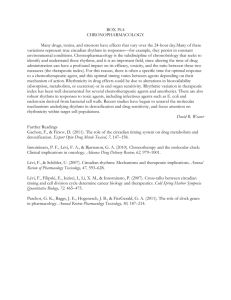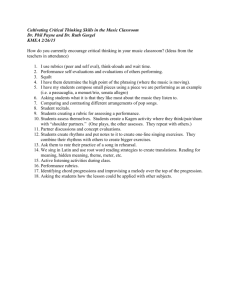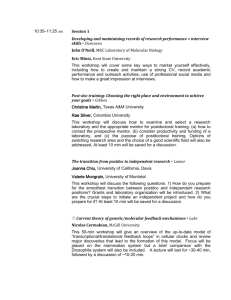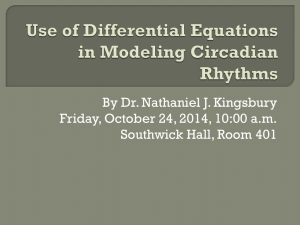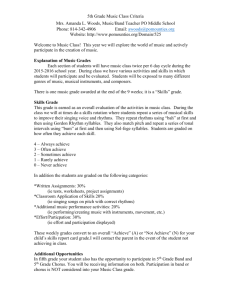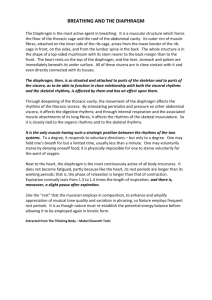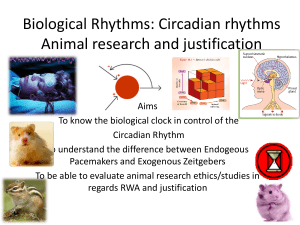Supplementary Information - Word file (66 KB )
advertisement
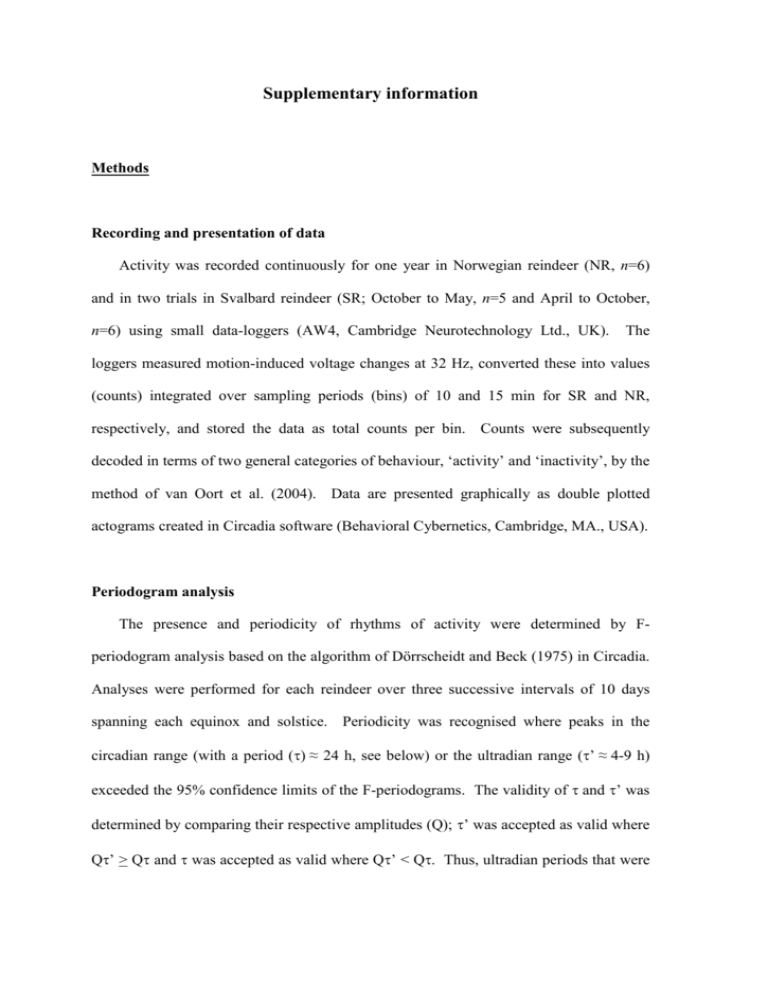
Supplementary information Methods Recording and presentation of data Activity was recorded continuously for one year in Norwegian reindeer (NR, n=6) and in two trials in Svalbard reindeer (SR; October to May, n=5 and April to October, n=6) using small data-loggers (AW4, Cambridge Neurotechnology Ltd., UK). The loggers measured motion-induced voltage changes at 32 Hz, converted these into values (counts) integrated over sampling periods (bins) of 10 and 15 min for SR and NR, respectively, and stored the data as total counts per bin. Counts were subsequently decoded in terms of two general categories of behaviour, ‘activity’ and ‘inactivity’, by the method of van Oort et al. (2004). Data are presented graphically as double plotted actograms created in Circadia software (Behavioral Cybernetics, Cambridge, MA., USA). Periodogram analysis The presence and periodicity of rhythms of activity were determined by Fperiodogram analysis based on the algorithm of Dörrscheidt and Beck (1975) in Circadia. Analyses were performed for each reindeer over three successive intervals of 10 days spanning each equinox and solstice. Periodicity was recognised where peaks in the circadian range (with a period ()≈ 24 h, see below) or the ultradian range (’≈4-9 h) exceeded the 95% confidence limits of the F-periodograms. The validity of and ’ was determined by comparing their respective amplitudes (Q); ’ was accepted as valid where Q’ > Q and was accepted as valid where Q’ < Q. Thus, ultradian periods that were harmonics of circadian periods, or vice versa, were rejected. The relative amplitude of rhythms (d(Q)p) was calculated according to Gerkema et al. (1994). We used interval (bin) samples and, consequently, any period of x h could have fallen within the range of x ± one sampling interval (10 min for SR and 15 min for NR; e.g., Ruby et al., 2002). We therefore established critical ranges with which to distinguish potential circadian from diel rhythms. Critical ranges for τ at the solstices were 23.83 to 24.17 h for SR and 23.75 to 24.25 h for NR. The critical ranges for τ at the equinoxes were slightly different. At 70 and 78ºN, daylength changes by 10 and 20 min·day-1, respectively, around the equinoxes and the critical ranges were adjusted to compensate for this. Owing to the different rates of sampling, the resulting range was 23.67 to 24.33 h for both NR and SR. Only periodicities where ≈ 24 h which fell outside the critical ranges were considered as potential circadian rhythms. Date Periodo- Significant rhythms Arrhythmic grams Circadian Diel Ultradian N n τ d(Q)p n τ d(Q)p n τ' d(Q)p N* 18 Mar. 18 1 23.5 0.31 15 24.0 (23.8 - 24.3) 0.18 19 8 (6 - 8) 0.13 0 21 June 18 0 1 24.2 0.12 1 8 0.04 16 15 Sept. 18 0 12 24.0 (23.8 - 24.3) 0.12 10 6 (4 - 8) 0.08 5 3 Jan. 18 3 24.5 24.5 25.3 0.08 6 24.0 (24.0 - 24.3) 0.14 9 8 (6 - 8) 0.08 5 18 Mar. 15 3 23.0 24.5 25.0 0.12 2 24.3 24.3 0.12 24 8 (6 - 9) 0.07 0 21 June 18 0 1 24.3 0.11 27 6 (4 - 9) 0.05 4 15 Sept. 18 0 0 14 6 (5 - 9) 0.07 9 24 Dec. 15 0 0 25 8 (6 - 9) 0.11 1 midpoint of trials NR SR Supplementary Table 1. The prevalence and relative amplitude of rhythms of activity in reindeer. The table shows the prevalence (n) and relative amplitude (d(Q)p) of circadian ( 24 h), diel ( = 24 h) and ultradian (’ ≈4-9 h) rhythms of activity in Norwegian (NR, n = 6) and Svalbard reindeer (SR, n = 5 or 6). F-periodogram analysis was performed in each animal on records extracted from three consecutive periods, each lasting ten days, centred on the summer and winter solstices (June, December) and the spring and autumn equinoxes (March and September). The periodicity of significant rhythms (and ’) detected in each trial is expressed either as individual values (n < 3) or as the median (range; n > 3). The d(Q)p values are trial medians. N = number of 10-day periodograms; n = number of significant rhythms in the pooled sample for each trial; N* = number of 10-day periodograms in which no significant periodicity (or ’) was detected. All harmonics are excluded and only true rhythmicity, therefore, is considered. Consistent with visual inspection of the actograms, periodogram analysis revealed that, with two exceptions, neither NR nor SR displayed diel or circadian rhythms in June. Furthermore, NR displayed diel rhythmicity under light/dark cycles in September, January and March while SR, by contrast, displayed only a tendency for daily rhythmicity and only in March. Both sub-species displayed significant ultradian rhythmicity throughout the year, with the exception of NR in June. The average (median) periodicity of the ultradian rhythms varied between 6 and 8 h, equivalent to between three and four cycles per day. References Dörrscheidt G.L. and Beck, L (1975) Advanced methods for evaluating characteristic parameters (alpha, tau, rho) of circadian rhythms. J. Math. Biol. 2: 107-121. Gerkema M.P., van der Zee, E.A. and Feitsma, L. (1994) Expression of circadian rhythmicity correlates with the number of arginine-vasopressin immunoreactive cells in the suprachiasmatic nucleus of common voles, Microtus arvalis. Brain. Res. 639: 93101. Ruby, N.F., Joshi, N. and Heller, H.C. (2002) Constant darkness restores entrainment to phased-delayed Siberian hamsters. Am. J. Physiol. Regul. Integr. Comp. Physiol. 283: R1314-R1320. Van Oort, B.E.H., Tyler, N.J.C., Storeheier, P.V., Stokkan K.-A. (2004) The performance and validation of a data logger for long-term determination of a1ctivity in free-ranging reindeer, Rangifer tarandus (L.) Appl. Anim. Behav. Sci. 89: 299-308.

